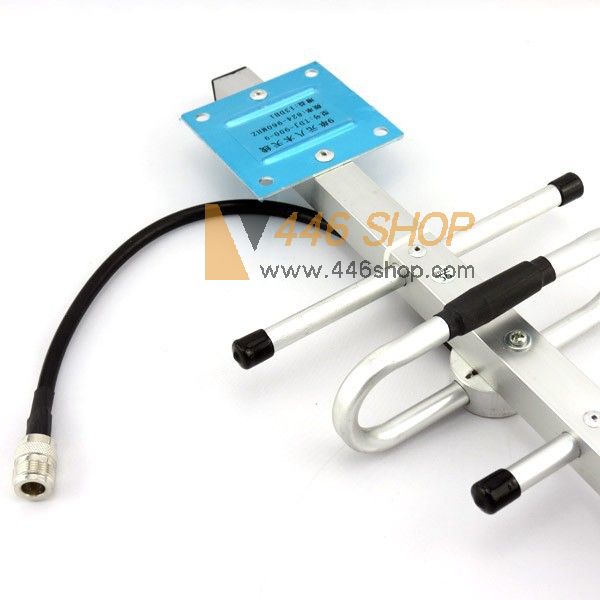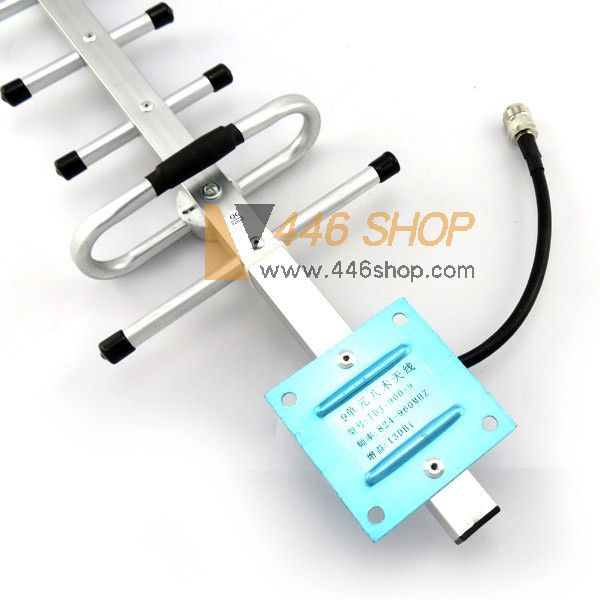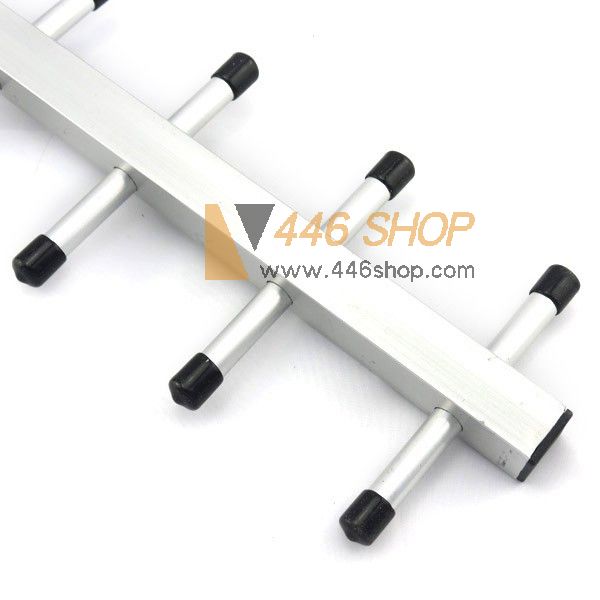High Gain Yagi Antenna Directional Outdoor Antenna 13dBi 850/900 MHz
Features:
Aluminum alloy structure; Optimized dimension;
All-weather work;
High Gain 13dBi;Low VSWR;
Can be installed in vertical or horizontal polarization
Apply for: 824-960MHz system; CDMA/GSM/ System; Terminal antenna
Specifications:
Frequency Range: 824-960MHz
Gain: 13dBi
F/B Ratio: ≥16
VSWR: ≤1.5
Input Impedance: 50Ω
Polarization: Vertical or horizontal
Max power: 150W
Lightning protection: DC ground
Connector model: N Female
Working Temperature: -40-60 °c
Color: silver
Rated Wind Velocity: 60m/s
Size: 68cm*16.5cm*6cm
N.W.: 450g
If bulk order, please contact Ms. Amy Huang:
Tel: 86(592)2653580
Fax: 86(592)3720556
SKYPE: amy.446shop
Email: amy@446shop.com





Description for Antenna:
Antennas are required by any radio receiver or transmitter to couple its electrical connection to the electromagnetic field. Radio waves are electromagnetic waves which carry signals through the air (or through space) at the speed of light with almost no transmission loss. Radio transmitters and receivers are used to convey signals (information) in systems including broadcast (audio) radio, television, mobile telephones, Wi-Fi (WLAN) data networks, trunk lines and point-to-point communications links (telephone, data networks), satellite links, many remote controlled devices such as garage door openers, and wireless remote sensors, among many others. Radio waves are also used directly for measurements in technologies including RADAR, GPS, and radio astronomy. In each and every case, the transmitters and receivers involved require antennas, although these are sometimes hidden (such as the antenna inside an AM radio or inside a laptop computer equipped with Wi-Fi).
According to their applications and technology available, antennas generally fall in one of two categories:
1) Omnidirectional or only weakly directional antennas which receive or radiate more or less in all directions. These are employed when the relative position of the other station is unknown or arbitrary. They are also used at lower frequencies where a directional antenna would be too large, or simply to cut costs in applications where a directional antenna isn't required.
2) Directional or beam antennas which are intended to preferentially radiate or receive in a particular direction or directional pattern.
In common usage "omnidirectional" usually refers to all horizontal directions, typically with reduced performance in the direction of the sky or the ground (a truly isotropic radiator is not even possible). A "directional" antenna usually is intended to maximize its coupling to the electromagnetic field in the direction of the other station, or sometimes to cover a particular sector such as a 120° horizontal fan pattern in the case of a panel antenna at a cell site.
Basic antenna models:
There are many variations of antennas. Below are a few basic models. More can be found in Category:Radio frequency antenna types.
• The isotropic radiator is a purely theoretical antenna that radiates equally in all directions. It is considered to be a point in space with no dimensions and no mass. This antenna cannot physically exist, but is useful as a theoretical model for comparison with all other antennas. Most antennas' gains are measured with reference to an isotropic radiator, and are rated in dBi (decibels with respect to an isotropic radiator).
• The dipole antenna is simply two wires pointed in opposite directions arranged either horizontally or vertically, with one end of each wire connected to the radio and the other end hanging free in space. Since this is the simplest practical antenna, it is also used as a reference model for other antennas; gain with respect to a dipole is labeled as dBd. Generally, the dipole is considered to be omnidirectional in the plane perpendicular to the axis of the antenna, but it has deep nulls in the directions of the axis. Variations of the dipole include the folded dipole, the half wave antenna, the ground plane antenna, the whip, and the J-pole.
• The Yagi-Uda antenna is a directional variation of the dipole with parasitic elements added which are functionality similar to adding a reflector and lenses (directors) to focus a filament light bulb.
• The random wire antenna is simply a very long (at least one quarter wavelength[citation needed]) wire with one end connected to the radio and the other in free space, arranged in any way most convenient for the space available. Folding will reduce effectiveness and make theoretical analysis extremely difficult. (The added length helps more than the folding typically hurts.) Typically, a random wire antenna will also require an antenna tuner, as it might have a random impedance that varies non-linearly with frequency.
• The horn antenna is used where high gain is needed, the wavelength is short (microwave) and space is not an issue. Horns can be narrow band or wide band, depending on their shape. A horn can be built for any frequency, but horns for lower frequencies are typically impractical. Horns are also frequently used as reference antennas.
• The parabolic antenna consists of an active element at the focus of a parabolic reflector to reflect the waves into a plane wave. Like the horn it is used for high gain, microwave applications, such as satellite dishes.
• The patch antenna consists mainly of a square conductor mounted over a groundplane. Another example of a planar antenna is the tapered slot antenna (TSA), as the Vivaldi-antenna.




